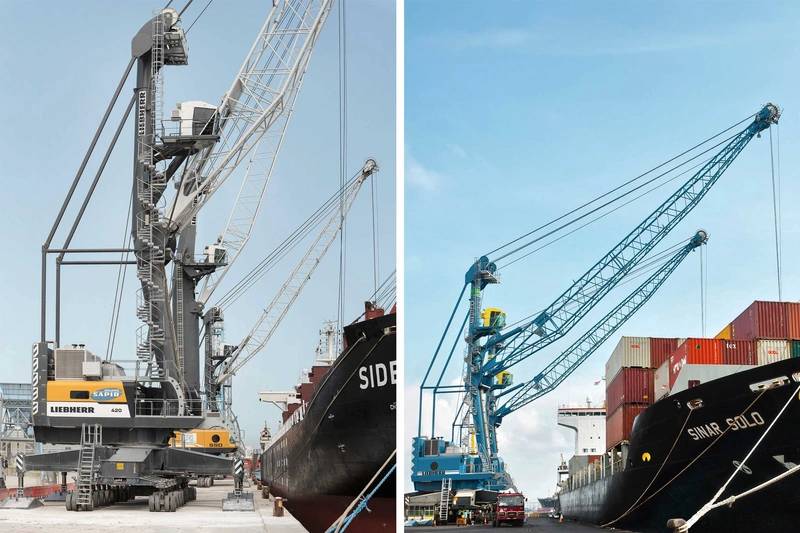Liebherr Celebrates 50 Years of Excellence
The LGM 1130 introduced in 1974 was Liebherr’s first mobile harbour crane, and the LHM has evolved with innovative design features and technological advancements. This month, Liebherr celebrates over one half century of innovation.
Over the decades, Liebherr has continuously adapted to market demands, introducing innovative models such as the LHM 250 in 1996 and the LHM 550 in 2010– The all-electric LPS 420 E from 2019 and the new LHM series introduced in 2022 reflect Liebherr’s commitment to sustainability and forward-looking technologies.

Progress evolves with the times and new lessons gained from experience. Liebherr has developed its flagship mobile harbour crane over five decades of changing industry demands, standards, and trends. Upgrades over the years have ultimately served to accommodate larger and heavier cargoes, while maintaining high standards in performance and reliability. This has included updates to the crane’s tower and boom, to modifications in its undercarriage. In recent years, all-electric cranes optimised for energy efficiency and sustainability have come to the forefront. And the newest LHM series focuses on advanced electronics and sensor technology for future automation.
The legacy and evolution of the Liebherr mobile harbour crane couldn’t be more illustrative than with the LGM 1130 introduced in 1974. Mobile harbour cranes in those times were often used as backup for STS container cranes, positioned under the container crane itself. This was made possible through a folding tower design that allowed the LGM to fold its boom, drive underneath the container crane, and erect itself again to then support the STS. The LGM was introduced during a period when containerisation was becoming increasingly dominant, and global trade routes were expanding.
Mobile harbour cranes are renowned for their flexibility and versatility, and this trait was reinforced over time. Capable of handling various applications such as bulk handling, container handling, and heavy goods transport, these cranes needed to offer more efficiency compared to other port equipment. The rubber-tired undercarriage provides excellent load distribution, eliminating the need for extensive quay preparation and allowing for easy transition to new projects or ports.
With the introduction of the LHM 250 in 1996, new benchmarks for efficiency and innovation were set. This crane featured an X-shaped undercarriage and individually steerable wheelsets, allowing for improved manoeuvrability in increasingly narrow port environments. The LHM 250 was also the first Liebherr mobile harbour crane to incorporate telemetry, enabling remote monitoring and data transmission. This innovation was crucial as the industry demanded greater efficiency and larger cranes to handle the growing size and capacity of container ships.
“Over the years, Liebherr has continuously adapted to market demands, introducing groundbreaking models that have had an impact on port operations,” says Sebastian Simon, product manager at Liebherr Rostock. “Our commitment to innovation and quality has made us a trusted partner in the maritime industry.”
One of the standout developments in port logistics over the past decade is the increasing demand for a more sustainable infrastructure. In 2019, the LPS 420 E marked a significant milestone as Liebherr’s first all-electric portal crane. It features permanently excited synchronous motors, significantly reducing energy consumption, especially during idling times. All crane movements – like luffing, hoisting, slewing, and travelling – were done by electric motors, no hydraulics required. The LPS 420 E was designed for high-efficiency bulk and container operations, reflecting the industry’s increasing focus on reducing CO2 footprints. But it was not the first innovation for electric drives.
For more than a quarter century now, Liebherr mobile harbour cranes do not emit any CO2 during operation when their electric prime movers are in operation, according to the Scope 1 GHG protocol, and provided that the port has the corresponding infrastructure for it. The new LHM series, released in 2022, represents the future of crane technology with its advanced automation capabilities. This crane is prepared for supervised work cycle automation, preparing ports for the future of data-driven logistics and renewable infrastructure.
Liebherr’s vision for the future includes more data-driven logistics, which will improve the operations of maritime crane fleets through mastery over data access and optimization. The company also anticipates a significant growth in renewable infrastructure at ports, aiming to reduce local emissions and source more renewable energy. Liebherr’s mobile harbour cranes are already prepared for these trends, characterized by low noise, high precision, high speed, and reduced operational expenses.
“The goals for the next half-century are clear: continuous technical enhancements of the cranes, swift adaptation to new developments, and maintaining the agility of a family-owned business with short decision-making pathways,” remarks Andreas Ritschel, General Manager Sales for mobile harbour cranes at Liebherr-MCCtec Rostock GmbH. “Reliability remains a cornerstone, both in the products and the service expansion. With a steadfast presence for 75 years and 50 years of experience and innovation in mobile harbour cranes, Liebherr is poised to remain an industry leader for the next 50 years.”
